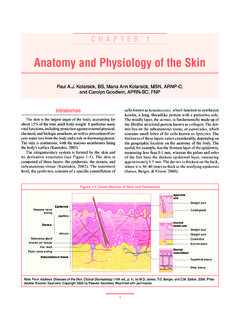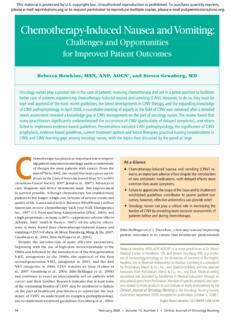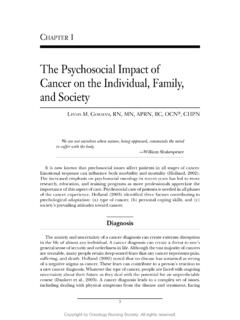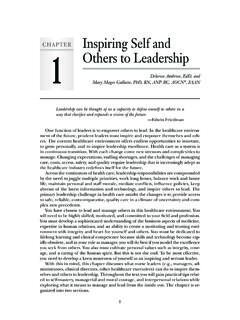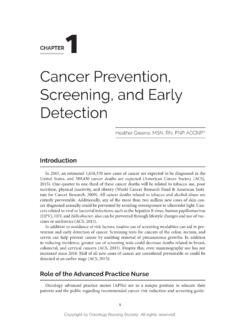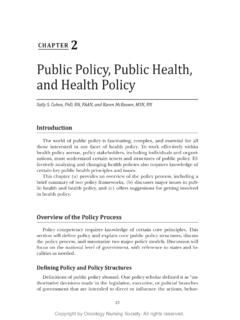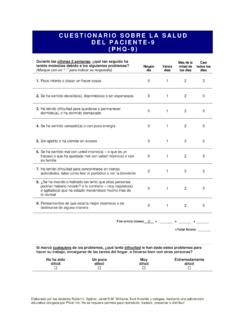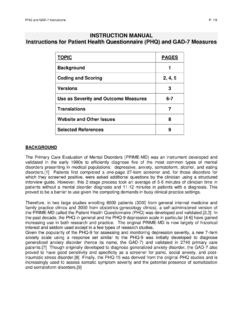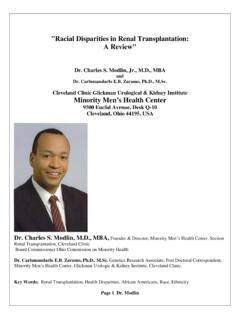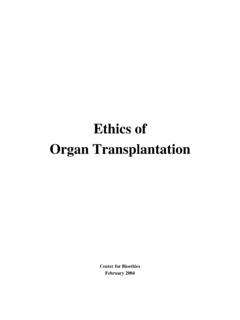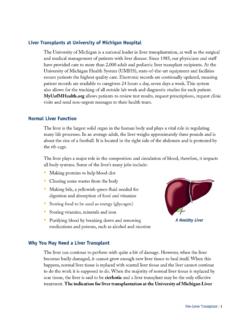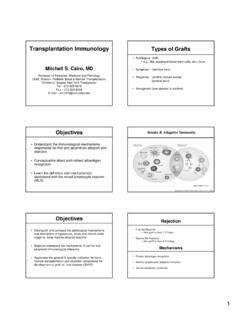Transcription of Basic Concepts and Indications for Transplantation
1 1 CHAPTER 1 Basic Concepts and Indications for TransplantationMartha Lassiter, RN, MSN, AOCNS , BMTCN I. IntroductionA. The immune system comprises various components that work in tandem to pro-vide immunity and maintain homeostasis. The use of hematopoietic stem cell trans-plantation (HSCT) to treat various malignant and nonmalignant diseases in the last 30 years has become an increased standard treatment for many conditions. Knowledge of Basic Concepts of HSCT provides a foundation for understand-ing the intricacies of Transplantation to provide quality care and better support to patients and their Basic Concepts of Transplantation (Devine, 2013)a) Hematopoiesis and immunology provide the scientific basis for HSCT. Two types of bone marrow exist: red bone marrow and yellow bone mar-row. Red bone marrow produces hematopoietic stem cells that create red blood cells, white blood cells, and platelets and is found in the long and flat bones.
2 Yellow bone marrow and fat cells produce stromal stem cells that produce fat, cartilage, and bone and are found in the long ) Components of hematopoiesis(1) Hematopoietic stem cells develop prior to birth and are produced in the long bones during childhood and then the axial skeleton in adulthood.(2) Bone marrow microenvironment: The bone marrow stroma is the hous-ing unit and hub of cellular activity.(3) Cellular adhesion molecules(4) Chemokines, cytokinesc) The main objective of hematopoiesis is to maintain the peripheral blood with the proper level of blood components. The pluripotent stem cells mature and differentiate into the myeloid or lymphoid progenitor cells within the bone marrow (see Figure 1-1).(1) Myeloid progenitor cells mature into the following:(a) Megakaryocytes (produce platelets)(b) Erythrocytes(c) Mast cells(d) MyeloblastsCopyright by Oncology Nursing Society. All rights BMTCN Certification Review ManualFigure 1-1.
3 HematopoiesisNote. Copyright 2014 by Oncology Nursing Society. Used with by Oncology Nursing Society. All rights 1. Basic Concepts and Indications for Transplantation 3(2) Lymphoid progenitor cells mature into the following:(a) Small lymphocytes, which differentiate into bone marrow derived cells (B cells) and thymus-derived cells (T cells)(b) Natural killer (NK) cellsd) Immune function is dependent on ) Primary organs of the immune system are involved in production, matura-tion, and immune activity.(1) Bone marrow(2) Thymus gland: Located in the anterior mediastinum and forms T cells(3) Lymph nodes: Bean-shaped glands that cluster throughout the body in the neck, chest, axillae, abdomen, and inguinal region and function as an immunologic filter(4) Spleen: Organ responsible for filtering white cells, platelets, and other substancesf ) The immune system consists of innate immunity and acquired immunity.(1) Innate immunity occurs naturally and uses phagocytes that release inflammatory mediators and NK cells.
4 (2) Acquired immunity is the response of either B cells or T cells to antigens.(3) B-cell activation can be T-cell dependent or ) Hematopoiesis is affected by senescence (loss of the cell s power to divide and grow) (Allsopp & Weissman, 2002; Nuss, Barnes, Fisher, Olson, & Skeens, 2011; Shao et al., 2013).(1) Hematopoietic stem cell senescence naturally occurs with age but also is affected by cancer treatment and Transplantation .(2) Reduction in size of thymus and function of immune cells (not neces-sarily a reduction in number) is called immunosenescence.(3) Reduced size and function of thymus after puberty(4) Decreased cell-producing marrow with ageh) Immune function(1) Myeloid cells are the first responders to injury and are not pathogen specific.(2) Lymphoid cells respond later and are pathogen Donor identification (allogeneic only) and types of Transplantation (Bray et al., 2008). Types of transplant include autologous and allogeneic (see Table 1-1).
5 A) Human leukocyte antigen high-resolution typing provides the degree of genetic match between a matched unrelated donor and a recipient in prep-aration for allogeneic ) A better match is preferred because(1) Potential for improved overall survival with a matched donor and recipient(2) Reduced incidence of graft-versus-host disease (GVHD)(3) Improved engraftment rates3. Role of the caregivera) Provide physical and emotional ) Assist with physical recovery following ) Assist with take-home medication by Oncology Nursing Society. All rights BMTCN Certification Review Manuald) Perform care of central venous catheter ( , flushing and dressing changes).e) Assess for signs of infection ( , fevers).f ) Monitor ) Perform food ) Provide transportation to and from the hospital or ) Aid in symptom ) Communicate with healthcare Informal/family caregiver self-carea) Restb) Balanced dietc) Exercise/stress reductiond) Management of personal health needs ( , medications) and personal support5.
6 Goals of therapya) Nonmalignant diseases: Cell line replacement ( , chronic granulomatous disease, sickle-cell disease, aplastic anemia)b) Malignant diseases: Tumor ablationTable 1-1. Types of Allogeneic Hematopoietic Stem Cell TransplantationType of TransplantCell SourceAdvantagesDisadvantagesSyngeneicId entical twinNo need for immuno-suppressionNo graft-versus-tumor effectMatched sibling/relatedHuman leukocyte antigen (HLA)-identical relativeNo potential stem cell contaminationAccess to cells because donor is relatedOnly 25% of population has a sibling matchRisk of graft-versus-host dis-ease (GVHD)Mismatched relatedHLA-nonidentical relativeNo potential stem cell contaminationIncreased number of potential donorsIncreased risk of GVHDI ncreased risk of graft failure related to HLA disparityMatched unre-latedHLA-identical unre-lated donorNo potential stem cell contaminationIncreased risk of GVHDL imited numbers of non-Cau-casian donorsWaiting period to identify donorMismatched unrelatedHLA-nonidentical unrelated donorNo potential stem cell contaminationIncreased risk of GVHDHigh treatment-related mortalityUmbilical cord bloodUmbilical cord unitEasy access to cell sourceLimited number of cellsDelayed time to engraftmentIncreased infection ratesNote.
7 From Basic Concepts of Transplantation (p. 15), by D. Niess in Ezzone (Ed.), Hematopoietic Stem Cell Transplantation : A Manual for Nursing Practice (2nd ed.), 2013, Pittsburgh, PA: Oncology Nursing Society. Copyright 2013 by Oncology Nursing Society. Reprinted with by Oncology Nursing Society. All rights 1. Basic Concepts and Indications for Transplantation 56. Graft-versus-tumor effecta) Promoted by withdrawal of immunosuppressant therapyb) Promoted by donor lymphocyte infusionsc) Decreased in the absence of acute GVHDd) Associated with higher rates of cancer relapse7. Immune reconstitution (Storek & Witherspoon, 2004)a) Dependent on patient s hematologic response to preparative regimenb) Dependent on rate of engraftmentc) Dependent on survival and longevity of mature lymphocytes present at the time of transplantd) Delayed in patients with chronic GVHDe) Quantitative recovery of immune function does not always correlate with qualitative ) Immune reconstitution may take months to Phases of immune reconstitutiona) Numeric recovery of bone marrow elementsb) Functional recovery of cellular interactionsB.
8 Indications for Transplantation (Pasquini & Zhu, 2016)1. Common malignant and nonmalignant diseases treated with HSCT (see Table 1-2)2. Autoimmune diseases treated under a clinical trial (Sullivan, Parkman, & Wal-ters, 2000)a) Sclerodermab) Multiple sclerosisc) Systemic lupus erythematosusd) Rheumatoid arthritise) Crohn diseaseTable 1-2. Common Diseases Treated With Hematopoietic Stem Cell TransplantType of DiseaseAutologous TransplantAllogeneic TransplantMalignantHematologic malignan-ciesHodgkin diseaseNon-Hodgkin lymphomaMultiple myelomaAcute lymphocytic leukemiaAcute myeloid leukemiaChronic myeloid leukemiaMyelodysplastic syndromesNon-Hodgkin lymphomaJuvenile myelomonocytic leukemiaSolid tumorsNeuroblastomaSarcomaGerm cell tumorsBrain tumorsBreast cancerOvarian cancerMelanomaLung cancer (Continued on next page)Copyright by Oncology Nursing Society. All rights BMTCN Certification Review ManualKey Points Nursing care of patients undergoing hematopoietic stem cell Transplantation (HSCT) requires an understanding of Basic hematopoiesis and immunology principles.
9 As knowledge of the immune system has expanded, the patient population that might benefit from HSCT also has expanded beyond hematologic malignancies. Whether patients have a diagnosis of cancer or other illness, informal/family caregivers require rigorous education and support to assist with the necessary care throughout the transplant process and beyond into recovery and , , & Weissman, (2002). Replicative senescence of hematopoietic stem cells during serial transplanta-tion: Does telomere shortening play a role? Oncogene, 21, 3270 3273. 1-2. Common Diseases Treated With Hematopoietic Stem Cell Transplant (Continued)Type of DiseaseAutologous TransplantAllogeneic TransplantNonmalignantHematologic Severe aplastic anemiaFanconi anemiaThalassemiaSickle-cell diseaseDiamond-Blackfan anemiaCh diak-Higashi syndromeChronic granulomatous diseaseCongenital neutropeniaImmunodeficiency Severe combined immunodeficiency diseaseWiskott-Aldrich syndromeFunctional T-cell deficiencyGenetic AdrenoleukodystrophyMetachromatic leukodystrophyHurler syndromeHunter diseaseGaucher syndromeMiscellaneous OsteopetrosisLangerhans cell histiocytosisGlycogen storage diseasesNote.
10 Based on information from Ezzone, 2009; Nuss et al., 2011; Pasquini & Wang, Basic Concepts of Transplantation (p. 14), by D. Niess in Ezzone (Ed.), Hematopoietic Stem Cell Trans-plantation: A Manual for Nursing Practice (2nd ed.), 2013, Pittsburgh, PA: Oncology Nursing Society. Copyright 2013 by Oncology Nursing Society. Reprinted with by Oncology Nursing Society. All rights 1. Basic Concepts and Indications for Transplantation 7 Bray, , Hurley, , Kamani, , Woolfrey, A., M ller, C., Spellman, S., .. Confer, (2008). National Marrow Donor Program HLA matching guidelines for unrelated adult donor hematopoietic cell transplants. Biology of Blood and Marrow Transplantation , 14(Suppl. 9), 45 53. , H. (2013). Overview of hematopoiesis and immunology: Implications for hematopoietic stem cell trans-plantation. In Ezzone (Ed.), Hematopoietic stem cell Transplantation : A manual for clinical practice (2nd ed.)
